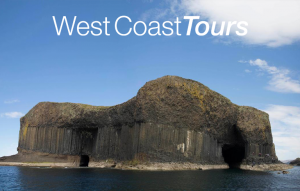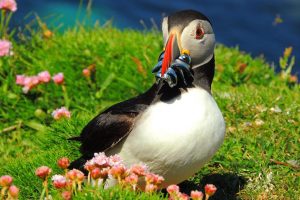Staffa & Fingals Cave Treshnish Wildlife Tour (Sails from August)
-
Departs:
Tobermory, Ardnamurchan
- 4 hours
£ 60
Staffa and Treshnish Isles Wildlife Tour from Fionnphort or Iona
-
Departs:
Iona, Fionnphort
- 6 hours
£ 85
The waters around Mull, Staffa and Iona are home to a few species of dolphin and porpoise. Species that we see regularly are common dolphin, bottlenose dolphin and harbour porpoise.
Out in open water, it is common to see dolphins and porpoises surfacing and jumping with regularity, and the dolphins in particular love to bow ride alongside the boats. The dolphins prefer to move together in pods and come to the surface to breathe but also to jump around and play which is what everyone really comes to see.
Bottlenose dolphin
The bottlenose dolphins are identifiable by their dark backs and light underside, are almost double the length of common dolphins and are five times heavier. It is perhaps the most familiar looking of all dolphins because its lower jaw protrudes which makes it look like it has a permanent smile.
Common dolphins
Common dolphins are grey in colour with a white underbelly and smaller than bottlenose dolphins growing to between 6-8ft long and up to 500lb in weight. Their pods usually number between 10-30 although in some parts of the world pods of several hundred have been reported. Common dolphins spend half the year in Scottish waters between May and October when there is an abundance of food and for they remain months they return to the warmer, deeper waters of tropical seas.
Perhaps the most endearing aspect of common dolphins is their acrobatics. When they are not feeding they leap and splash creating sounds that can be heard from miles away. Up close, they can be seen swimming very fast (around 15mph) and jumping clear out of the water which always brings gasps and smiles to guests of Staffa Tours.
Dolphins bow riding with Staffa Tours
Harbour porpoise
In contrast to the dolphins, the porpoises are much smaller and tend to travel in smaller groups of two to five and the majority of sightings are of them only just breaking the surface. Although not as acrobatic as dolphins, it is still exciting to see these marine mammals swimming gracefully alongside the boat.
Unfortunately, thousands of Harbour Porpoise are caught accidentally in fishing nets every year in UK waters and threatens their survival. However, to prevent this needless waste of marine life, many fishermen are now using creels rather than monofilament nets to protect the porpoises.





